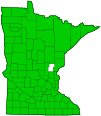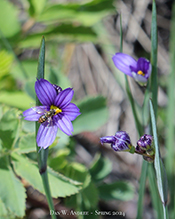blue-eyed grasses
(Sisyrinchium spp.)
Overview • Description • Distribution • Taxonomy
Description |
Sisyrinchium plants grow in clumps. The roots are fibrous. There are underground stems (rhizomes), but these may be obscure when the plants grow in clumps. There are 2 to 6 leaves. They may be all basal, or there may be some basal and some low on the stem, nearly basal. The leaf blades are linear, narrow, and sword-like – stiff and erect. They are usually hairless. There are usually 2 or more flowering stems. The stems are erect, flattened, and usually winged. They may be branched or unbranched. There are 1 to 4 inflorescences per flowering stem. Each inflorescence is a cluster of 2 to 11 flowers, rarely up to 15 flowers, at the end of the stem. The inflorescence is subtended and partially enclosed by a pair of claw-like bracts (spathes). Each flower has 3 petals, 3 petal-like sepals (6 tepals), 3 stamens, and 3 styles. The tepals are spreading or bent backward, and are bluish violet to light blue, white, lavender to pink, magenta, purple, or yellow. The fruit is a globe-shaped seed capsule. |
Distribution |
||
|
Sources |
|
| 5/30/2024 | ||
Taxonomy |
|
Kingdom |
|
Division |
Tracheophyta (Vascular Plants) |
Subdivision |
Spermatophytina (Seed Plants) |
Class |
Liliopsida (Monocots) |
Order |
Asparagales (Agaves, Orchids, Irises, and Allies) |
Family |
Iridaceae (irises and allies) |
Subfamily |
Iridoideae |
Tribe |
Sisyrinchieae |
Subordinate Taxa |
|
Alaska blue-eyed grass (Sisyrinchium littorale) annual blue-eyed grass (Sisyrinchium rosulatum) bigroot blue-eyed grass (Sisyrinchium radicatum) blue pigroot (Sisyrinchium micranthum) blue-eyed grass (Sisyrinchium arizonicum) coastal plain blue-eyed grass (Sisyrinchium fuscatum) dwarf blue-eyed grass (Sisyrinchium minus) eastern blue-eyed grass (Sisyrinchium atlanticum) Elmer’s blue-eyed grass (Sisyrinchium elmeri) Funeral Mountain blue-eyed grass (Sisyrinchium funereum) Greenland blue-eyed grass (Sisyrinchium groenlandicum) Hitchcock’s blue-eyed grass (Sisyrinchium hitchcockii) Idaho blue-eyed grass (Sisyrinchium idahoense) jeweled blue-eyed grass (Sisyrinchium xerophyllum) limestone blue-eyed grass (Sisyrinchium calciphilum) Miami blue-eyed grass (Sisyrinchium miamiense) mountain blue-eyed grass (Sisyrinchium sarmentosum) narrow-leaved blue-eyed grass (Sisyrinchium angustifolium) Nash’s blue-eyed grass (Sisyrinchium nashii) needle blue-eyed grass (Sisyrinchium capillare) needle-tip blue-eyed grass (Sisyrinchium mucronatum) Nevada blue-eyed grass (Sisyrinchium halophilum) nodding blue-eyed grass (Sisyrinchium cernuum) northern blue-eyed grass (Sisyrinchium septentrionale) pale blue-eyed grass (Sisyrinchium pallidum) prairie blue-eyed grass (Sisyrinchium campestre) roadside blue-eyed grass (Sisyrinchium langloisii) spearbract blue-eyed grass (Sisyrinchium sagittiferum) spotted blue-eyed grass (Sisyrinchium pruinosum) stiff blue-eyed grass (Sisyrinchium demissum) strict blue-eyed grass (Sisyrinchium montanum var. montanum) sword-leaf blue-eyed grass (Sisyrinchium ensigerum) timberland blue-eyed grass (Sisyrinchium longipes) western blue-eyed grass (Sisyrinchium bellum) white blue-eyed grass (Sisyrinchium albidum) wiry blue-eyed grass (Sisyrinchium biforme) wishbone blue-eyed grass (Sisyrinchium dichotomum) yellow-eyed grass (Sisyrinchium californicum) |
|
Synonyms |
|
Hydastylus |
|
Common Names |
|
blue-eyed grasses |
|
Glossary
Rhizome
A horizontal, usually underground stem. It serves as a reproductive structure, producing roots below and shoots above at the nodes.
Spathe
One or two large bracts that subtend, hood, or sometimes envelope a flower or flower cluster, as with a Jack-in-the-Pulpit.
Wing
A thin, flat, membranous, usually transparent appendage on the margin of a structure.
Visitor Photos |
||
Share your photo of this plant. |
||
This button not working for you? |
||
Dan W. Andree |
||
2 Little Short ones... These two … were just by themselves and short to the ground compared to the other ones. I’m sure they are the same kind as some of the others sent just a shorter version. Still they caught my eye against a more subtle background. |
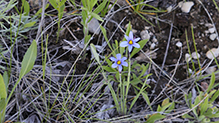 |
|
Flower fly on Blue-eyed Grass... Seen this little bee-like fly on I think some kind of Blue-eyed Grass that was blooming. Both flower and flower fly were real small. The flowers were smaller then some prairie blossom flowers even. |
||
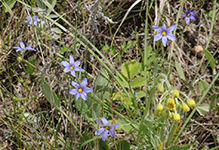 |
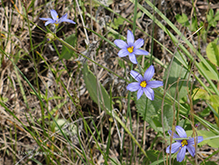 |
|
Lighter colored Blue-eyed Grass Blooming...
|
||
… cropped in image of the lighter colored .... … Prairies are not easy to capture plants, butterflies, bees etc. since just a light breeze can get a plant swaying back and forth etc. But anyway I like this lighter colored one about as much as the darker purplish ones. |
||
Tiny Bee on Blue-eyed Grass Blossom... This is that tiny bee on the blue-eyed grass. The flowers not to mention the little bees, flower flies etc. that land on them are hardly noticeable. I was going to try zoom in closer to get a better more detailed look but it flew off. I am sure it will be hard to tell what kind of little bee it is but anyway cute little thing. I filmed the little bee it was first on an upper blossom above where it is in this image then flew down and fed on that blossom. |
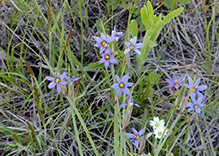 |
|
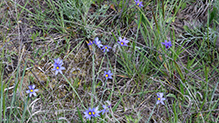 |
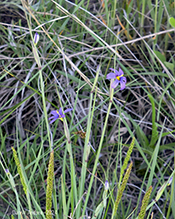 |
|
Crystal Boyd |
||
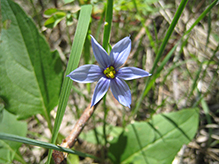 |
|
|
MinnesotaSeasons.com Photos |
||
|
||
|

Slideshows |
|

Visitor Videos |
||
Share your video of this plant. |
||
This button not working for you? |
||
|
Other Videos |
||
|

Visitor Sightings |
||
Report a sighting of this plant. |
||
This button not working for you? |
||
Dan W. Andree |
Location: On a prairie in Norman Co. Mn. Seen this little bee-like fly on I think some kind of Blue-eyed Grass that was blooming. Both flower and flower fly were real small. The flowers were smaller then some prairie blossom flowers even. |
 |
Crystal Boyd |
Location: Black Dog Preserve (now Minnesota Valley NWR, Black Dog Unit) |
 |
MinnesotaSeasons.com Sightings |
||
|

Created: 9/30/2023 Last Updated: © MinnesotaSeasons.com. All rights reserved. |
